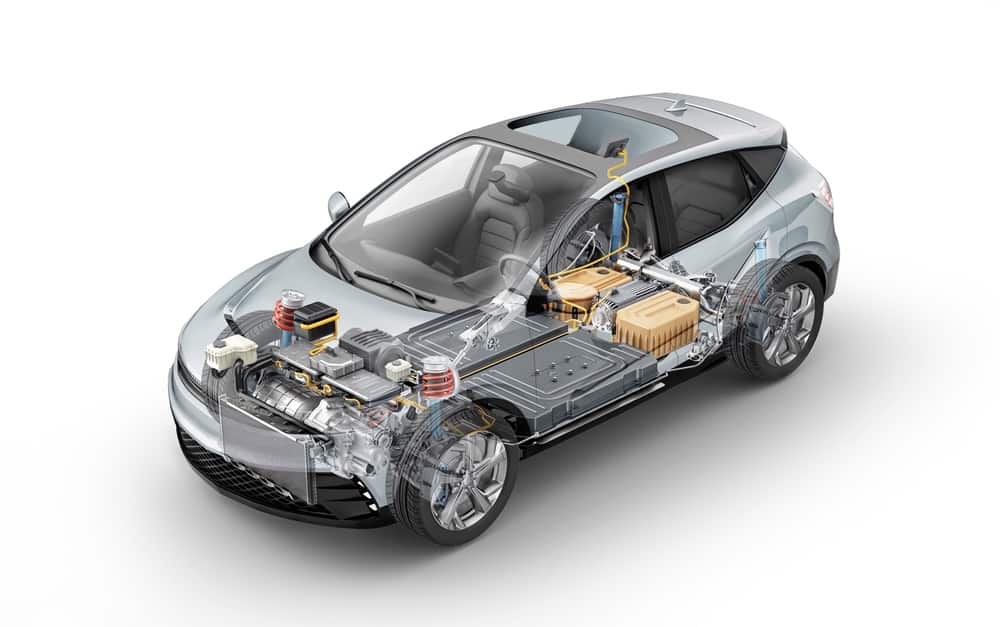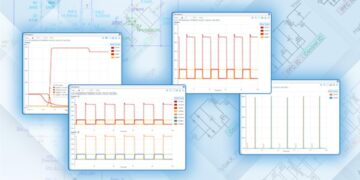
Generic electric vehicle – technical cutaway
In the coming decades, electric vehicles (EVs) will dominate our roads, with a lot of countries and states banning new internal combustion cars. The EV platform is radically different from that of gas-powered cars, so designers are rethinking their approach. This article explores the essentials of EV design.
There are two types of plug-in EVs: battery electric vehicles (BEVs) and plug-in hybrid electric vehicles (PHEVs). BEVs do not have conventional engines but are driven solely by one or more electric motors powered by energy stored in batteries. PHEVs use batteries to power an electric motor and another fuel, such as gasoline, to power a conventional engine.
New BEVs have a range of 100 to 400 miles on a full charge. PHEVs have an all-electric driving range of about 15 to 50 miles.
Ranges vary based on driving conditions and habits. Extreme temperatures reduce range because the battery also powers the climate control system. Speeding, aggressive driving, and heavy loads can also reduce the range.
|
BEVs vs PHEVs |
||
|
Factors |
BEVs |
PHEVs |
|
Driving Range |
100 to 400 miles on a full charge |
15 to 50 miles all-electric range |
|
Fuel Economy |
Fuel economy ratings higher than 100 mpge* |
Combined fuel economy ratings higher than 90 mpge* |
|
Emissions Reductions |
Produce no tailpipe emissions |
Produce no tailpipe emissions when in electric-only mode. |
|
Fuel Cost Savings |
BEVs run on electricity only; electricity costs are 2¢–6¢ per mile. |
In electric-only mode, PHEV electricity costs are 3¢–10¢ per mile; on gasoline only, fuel costs are about 4¢–36¢ per mile. |
|
Fueling Flexibility |
Can charge at:
|
Can fuel at gas stations; can charge at:
|
|
Source: U.S. Department of Energy Notes: *Miles per gallon equivalent (mpge) is the number of miles the vehicle can travel using a quantity of fuel (or electricity) with the same energy content as a gallon of gasoline. |
||
The Essential Elements of EV Design
Creating a functional and efficient EV, whether BEV or PHEV, involves several essential elements:
- Battery: An electric vehicle’s battery is its heart. The battery stores energy and powers the motor. A battery’s type, capacity, and chemistry affect the vehicle’s range, performance, and cost.
- Electric Motor: To drive the wheels, the electric motor converts electrical energy into mechanical energy. Electric motors come in many types, including AC induction motors and permanent magnet motors, each with advantages and applications.
- Power Electronics: Electrical energy flows between the battery and the electric motor through power electronic components, such as inverters and converters. They control the motor’s speed and direction, ensuring reliable power delivery and regenerative braking.
- Vehicle Structure: The vehicle’s structure should support the battery pack and electric motor while maintaining safety and structural integrity. Lightweight materials are often used in EVs to reduce weight and improve efficiency.
- Regenerative Braking: The regenerative braking system converts kinetic energy into electrical energy stored in the battery. This system extends the vehicle’s range and improves energy efficiency.
- Charging System: This system includes the charging port, onboard charger, and infrastructure. The EV can recharge from various power sources, including home chargers, public charging stations, and fast chargers.
- Thermal Management: A thermal management system is crucial to maintain optimal battery performance and prevent overheating.
- Energy Management System (EMS): The EMS optimizes energy flow between batteries, motors, and other vehicle components so they run more efficiently.
- User Interface: Drivers can monitor battery status, range, charging info, and more with an intuitive interface. Some EVs have smartphone apps that let owners control and monitor them remotely.
- Safety Features: EVs have to meet strict safety standards. Safety features like battery safety shields, electrical safety systems, and reinforced structures keep occupants safe.
- Aerodynamics: With a streamlined design and efficient aerodynamics, the vehicle has a longer range and saves energy.
- Connectivity/Autonomous Features: Most modern EVs have advanced connectivity features, over-the-air updates, and autonomous driving features.
Well-designed electric vehicles combine these elements to balance performance, efficiency, safety, and user experience.
![]()
The Role of Semiconductors in EVs
In EVs, semiconductors play a crucial role in design and functionality. They are essential components that enable various EV electronic systems to function efficiently and effectively.
Semiconductors’ role in EV systems:
- Power Electronics: Semiconductors, including MOSFETs and IGBTs, are used in power conversion systems to manage electrical energy, converting it from DC to AC (and vice versa) for motors and other devices.
- Battery Management System (BMS): The BMS manages the battery pack in an electric vehicle, making sure it’s safe, long-lasting, and performing efficiently. Microcontrollers and sensors in the BMS measure cell voltages, temperatures, and currents. They also balance the cells to keep them charging and discharging evenly.
- Motor Control: Semiconductors are employed in motor control units to regulate speed and torque. They are used to implement advanced motor control techniques, like pulse-width modulation (PWM), for smooth and precise motor control.
- Vehicle Control Systems: Most EVs have anti-lock braking systems (ABS), electronic stability control (ESC), and adaptive cruise control, which use semiconductors for real-time monitoring and adjusting of vehicle parameters.
- Infotainment and Connectivity: Semiconductors power infotainment and connectivity features like touchscreens, entertainment systems, GPS navigation, and wireless communication. Drivers can get essential information from these components, which enhances their driving experience.
- Advanced Driver Assistance Systems (ADAS): ADAS features like lane-keeping assist, collision avoidance, and adaptive headlights leverage semiconductors to process data from various sensors.
- Charging Infrastructure: Semiconductors are a big part of EV charging infrastructure. Charging stations use power electronics, microcontrollers, and communication chips to control charging, handle payments, and communicate with the EV for status updates and data exchange.
The need for more sophisticated and efficient semiconductors will grow as EV technology advances, pushing the industry to develop innovations to keep up.
Portfolio of EV Design Solutions
There is plenty of opportunity for EV design innovation in ADAS, smart charging infrastructures, and fleet management, as well as power management and in-vehicle networking. For example, the AWR2243, a small-form factor MMIC transceiver, simplifies automatic sensor integration for EV radar systems. And the XPN7R104NC, SSM6K804R, XPN3R804NC, and TPD7104AF are the driving components for a USB Buck-Boost DC-DC converter that delivers efficient power regulation for automotive systems.
Use Ultra Librarian’s electronics search engine to find PCB footprints, technical data, electronic computer-aided design (ECAD) and mechanical CAD models, or sourcing information for components. You can access component data and reference designs from popular manufacturers on this platform. The ECAD data on Ultra Librarian is compatible with popular ECAD applications and is verified by component manufacturers so you can streamline your EV design process.
Working with Ultra Librarian sets up your team for success to ensure streamlined and error-free EV design, production, and sourcing. Register today for free.








